iPhone 7 and 7 Plus unlikely to have major changes, but 2017 models could see significant revamp
Apple might ditch headphone plug in the 2016 iPhone variant.

Apple's 2016 iPhone models, which are expected this fall, will not be revamped completely in terms of design, but will feature subtle changes. Expect to see big changes in the variant lined up for 2017, suggests a new report.
The 2016 models, widely known as iPhone 7 and 7 Plus, would retain the current screen sizes: 4.7in and 5.5in respectively. One of the significant changes in this year's model is expected to be the removal of the headphone plug, which would make the phones thinner with improved water resistance capacity.
The lightning connector would serve dual purposes - to charge the phone as well as to connect the headphones, people familiar with the plan told The Wall Street Journal. Well known KGI Securities analyst Ming-Chi Kuo said the new iPhones are expected to be a millimetre thinner than the current model.
The reason this year's iPhone model is coming without major changes is apparently due to new technology being planned that would take time to be implemented. According to sources, the changes that Apple is planning to introduce such as the curved screen are not ready for this year's model.
Bigger changes for 2017 iPhone model
Apple has some big plans for the iPhone models for 2017, which would be the 10<sup>th anniversary of the iPhone. The changes expected are a complete OLED screen eliminating the home button and building the fingerprint sensor directly onto the display. This goes in line with what John Gruber of Daring Fireball had predicted earlier.
Talking about the sales part, when Apple introduced the iPhone with a bigger display in 2014, sales rose to 37% in the fiscal year ending September 2015. But when the iPhone 5s was launched with a design identical to the iPhone 5, sales increased to a mere 13%. Even the 2015 models – iPhone 6s and 6s Plus – failed to generate enthusiasm among fans as their design resembled that of the previous variants.
However, Apple does try its best to add significant improvements to iPhones even when the handset lacks design changes. For instance, the iPhone 5s carried the same look as its predecessor but came with a fingerprint sensor. So is the case with iPhone 6s and 6s Plus, which had a similar screen size but included a faster processor, new touch screen features along with better cameras.
© Copyright IBTimes 2025. All rights reserved.





















